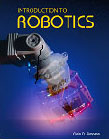Introduction to Robotics Textbook

Textbook to Accompany Industrial Robotics CBT
Copyright 2008, 430 pg
Hardcover
ISBN 0-9686860-3-6
The textbook, Introduction to Robotics, provides comprehensive treatment of the concepts of industrial robots and explains how they can be used in a plant or manufacturing system. The primary focus of the book is on automated manufacturing processes as well as the role of robots and all support equipment. Areas of study include motion programming, palletizing, conveyor systems, computer networking, automated sorting systems, vision and tactile sensors and computer integration. The book provides a unique, interdisciplinary treatment of robotics, and shows the contributions of the various fields of mechanical, electrical, and industrial engineering, and computer science, to robotics. It covers state-of-the-art topics such as artificial intelligence, CAD and graphic simulators, object-oriented software, communications systems, and micro- and nano-robots.
Introduction to Robotics is intended for students who will install, design, repair, maintain and develop industrial robotic systems. The level of content is suitable for colleges, universities, and technical institutes. Students using this book should have an understanding of algebra up to quadratic equations and of trigonometry to the simple properties of triangles. Knowledge of programming languages is useful, but not essential. This well-illustrated volume, with its numerous worked-out examples and chapter-ending questions, is sure to become indispensable in bridging the gap between design, automation, and control. The book focuses on the most commonly used robots in industry, and on issues and criteria related with designing, building and operating flexible and agile robotic systems. It explores in detail the issue of software interfaces, but also input/output devices using practical examples of common applications.
Key topics in the book include:
- Current industrial robotic equipment including manipulators, control systems, and programming environments.
- Software interfaces that can be used to develop distributed industrial manufacturing cells and techniques which can be used to build interfaces between robots and computers.
- Comprehensive treatment of robotic programming techniques
- Real-world applications with practical examples
The material covered in this book reflects the new generation of robotics developments. It is a powerful educational resource for students, engineers, and managers. It provides information on designing and building robotic manufacturing cells, and explores the capabilities of today’s industrial equipment as well as the latest computer and software technologies. Special attention is given to the input devices and systems that create efficient human-machine interfaces, and how they help non-technical personnel perform necessary programming, control, and supervision tasks. Taking an interdisciplinary approach to robotics, the book covers such topics as robot technology, robot programming, applications, machine vision, artificial intelligence, and related socio-economic considerations.
